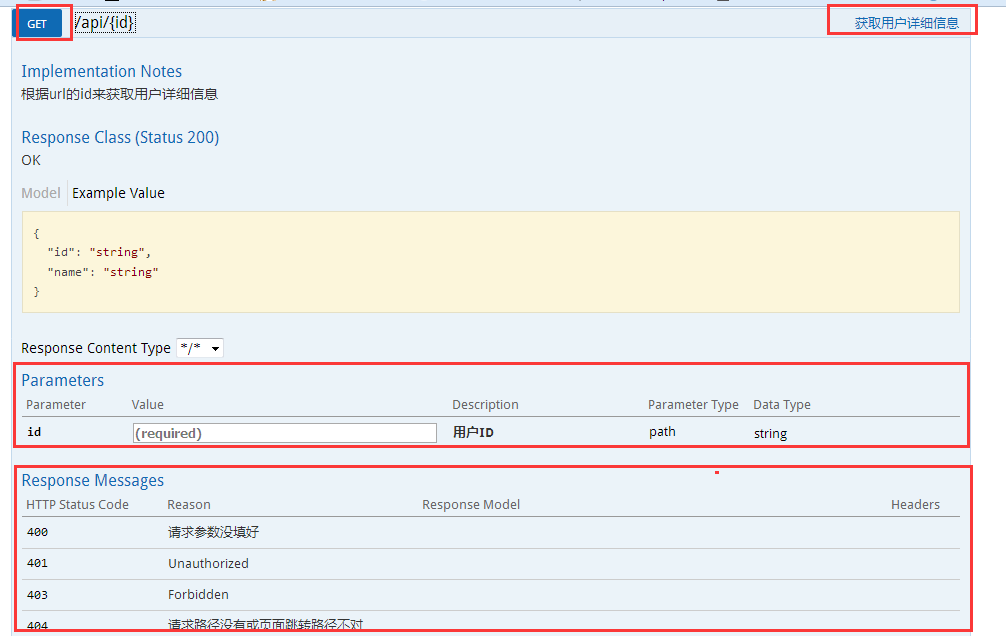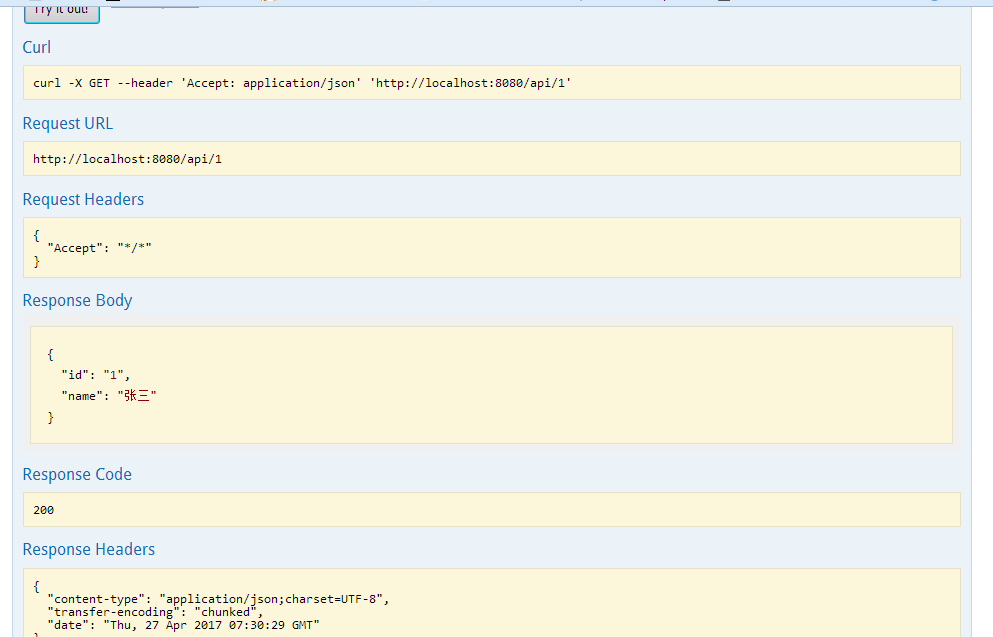您好,登錄后才能下訂單哦!
您好,登錄后才能下訂單哦!
本篇文章給大家分享的是有關使用spring boot如何實現對Swagger2進行整合,小編覺得挺實用的,因此分享給大家學習,希望大家閱讀完這篇文章后可以有所收獲,話不多說,跟著小編一起來看看吧。
Swagger 是一個規范和完整的框架,用于生成、描述、調用和可視化RESTful風格的 Web 服務。總體目標是使客戶端和文件系統作為服務器以同樣的速度來更新。文件的方法,參數和模型緊密集成到服務器端的代碼,允許API來始終保持同步。Swagger 讓部署管理和使用功能強大的API從未如此簡單。
1.代碼示例
1).在pom.xml文件中引入Swagger2
<dependency> <groupId>io.springfox</groupId> <artifactId>springfox-swagger2</artifactId> <version>2.6.1</version> </dependency> <dependency> <groupId>io.springfox</groupId> <artifactId>springfox-swagger-ui</artifactId> <version>2.6.1</version> </dependency>
2).在Application同級目錄下添加Swagger2的配置類
package com.example;
import org.springframework.context.annotation.Bean;
import org.springframework.context.annotation.Configuration;
import springfox.documentation.builders.ApiInfoBuilder;
import springfox.documentation.builders.PathSelectors;
import springfox.documentation.builders.RequestHandlerSelectors;
import springfox.documentation.service.ApiInfo;
import springfox.documentation.spi.DocumentationType;
import springfox.documentation.spring.web.plugins.Docket;
import springfox.documentation.swagger2.annotations.EnableSwagger2;
@Configuration
@EnableSwagger2
public class Swagger2Config {
@Bean
public Docket createRestApi() {
return new Docket(DocumentationType.SWAGGER_2)
.apiInfo(apiInfo())
.select()
.apis(RequestHandlerSelectors.basePackage("com.example"))
.paths(PathSelectors.any())
.build();
}
private ApiInfo apiInfo() {
return new ApiInfoBuilder()
.title("Spring Boot中使用Swagger2構建RESTful APIs")
.description("spring boot整合swagger2")
.termsOfServiceUrl("www.baidu.com")
.contact("牛頭人")
.version("1.0")
.build();
}
}如上代碼所示,通過 @Configuration 注解,讓Spring來加載該類配置。再通過 @EnableSwagger2 注解來啟用Swagger2。
通過 createRestApi 函數創建 Docket 的Bean之后, apiInfo() 用來創建該Api的基本信息(這些基本信息會展現在文檔頁面中)。 select() 函數返回一個 ApiSelectorBuilder 實例用來控制哪些接口暴露給Swagger來展現,本例采用指定掃描的包路徑來定義,Swagger會掃描該包下所有Controller定義的API,并產生文檔內容(除了被 @ApiIgnore 指定的請求)。
3).新建User實體類
package com.example.swagger2;
public class User {
private String id;
private String name;
public String getId() {
return id;
}
public void setId(String id) {
this.id = id;
}
public String getName() {
return name;
}
public void setName(String name) {
this.name = name;
}
}4).新建SwaggerDemoController類
package com.example.swagger2;
import java.util.ArrayList;
import java.util.Collections;
import java.util.HashMap;
import java.util.List;
import java.util.Map;
import org.springframework.web.bind.annotation.PathVariable;
import org.springframework.web.bind.annotation.RequestBody;
import org.springframework.web.bind.annotation.RequestMapping;
import org.springframework.web.bind.annotation.RequestMethod;
import org.springframework.web.bind.annotation.RestController;
import io.swagger.annotations.Api;
import io.swagger.annotations.ApiImplicitParam;
import io.swagger.annotations.ApiImplicitParams;
import io.swagger.annotations.ApiOperation;
import io.swagger.annotations.ApiResponse;
import io.swagger.annotations.ApiResponses;
@RestController
@RequestMapping(value="/api")
@Api("SwaggerDemoController相關api")
public class SwaggerDemoController {
static Map<String, User> users = Collections.synchronizedMap(new HashMap<String, User>());
@ApiOperation(value="獲取用戶列表", notes="")
@ApiResponses({
@ApiResponse(code=400,message="請求參數沒填好"),
@ApiResponse(code=404,message="請求路徑沒有或頁面跳轉路徑不對")
})
@RequestMapping(value={""}, method=RequestMethod.GET)
public List<User> getUserList() {
List<User> r = new ArrayList<User>(users.values());
return r;
}
@ApiOperation(value="創建用戶", notes="根據User對象創建用戶")
@ApiImplicitParam(name = "user", value = "用戶詳細實體user", required = true, dataType = "User")
@ApiResponses({
@ApiResponse(code=400,message="請求參數沒填好"),
@ApiResponse(code=404,message="請求路徑沒有或頁面跳轉路徑不對")
})
@RequestMapping(value="", method=RequestMethod.POST)
public String postUser(@RequestBody User user) {
users.put(user.getId(), user);
return "success";
}
@ApiOperation(value="獲取用戶詳細信息", notes="根據url的id來獲取用戶詳細信息")
@ApiImplicitParam(name = "id", value = "用戶ID",paramType="path", required = true, dataType = "String")
@ApiResponses({
@ApiResponse(code=400,message="請求參數沒填好"),
@ApiResponse(code=404,message="請求路徑沒有或頁面跳轉路徑不對")
})
@RequestMapping(value="/{id}", method=RequestMethod.GET)
public User getUser(@PathVariable String id) {
System.out.println("id="+id);
return users.get(id);
}
@ApiOperation(value="更新用戶詳細信息", notes="根據url的id來指定更新對象,并根據傳過來的user信息來更新用戶詳細信息")
@ApiImplicitParams({
@ApiImplicitParam(name = "id", value = "用戶ID",paramType="path", required = true, dataType = "String"),
@ApiImplicitParam(name = "user", value = "用戶詳細實體user", required = true, dataType = "User")
})
@ApiResponses({
@ApiResponse(code=400,message="請求參數沒填好"),
@ApiResponse(code=404,message="請求路徑沒有或頁面跳轉路徑不對")
})
@RequestMapping(value="/{id}", method=RequestMethod.PUT)
public String putUser(@PathVariable String id, @RequestBody User user) {
System.out.println("id="+id);
User u = users.get(id);
u.setName(user.getName());
users.put(id, u);
return "success";
}
@ApiOperation(value="刪除用戶", notes="根據url的id來指定刪除對象")
@ApiImplicitParam(name = "id", value = "用戶ID",paramType="path", required = true, dataType = "String")
@ApiResponses({
@ApiResponse(code=400,message="請求參數沒填好"),
@ApiResponse(code=404,message="請求路徑沒有或頁面跳轉路徑不對")
})
@RequestMapping(value="/{id}", method=RequestMethod.DELETE)
public String deleteUser(@PathVariable String id) {
System.out.println("id="+id);
users.remove(id);
return "success";
}
}說明:
@Api:用在類上,說明該類的作用
@ApiOperation:用在方法上,說明方法的作用
@ApiImplicitParams:用在方法上包含一組參數說明
@ApiImplicitParam:用在@ApiImplicitParams注解中,指定一個請求參數的各個方面
paramType:參數放在哪個地方
header-->請求參數的獲取:@RequestHeader
query-->請求參數的獲取:@RequestParam
path(用于restful接口)-->請求參數的獲取:@PathVariable
body(不常用)
form(不常用)
name:參數名
dataType:參數類型
required:參數是否必須傳
value:參數的意思
defaultValue:參數的默認值
@ApiResponses:用于表示一組響應
@ApiResponse:用在@ApiResponses中,一般用于表達一個錯誤的響應信息
code:數字,例如400
message:信息,例如"請求參數沒填好"
response:拋出異常的類
@ApiModel:描述一個Model的信息(這種一般用在post創建的時候,使用@RequestBody這樣的場景,請求參數無法使用@ApiImplicitParam注解進行描述的時候)
@ApiModelProperty:描述一個model的屬性
通過 @ApiOperation 注解來給API增加說明、通過 @ApiImplicitParams 、 @ApiImplicitParam 注解來給參數增加說明。
需要注意的是:

如果ApiImplicitParam中的phone的paramType是query的話,是無法注入到rest路徑中的,而且如果是path的話,是不需要配置ApiImplicitParam的,即使配置了,其中的value="用戶ID"也不會在swagger-ui展示出來。
具體其他的注解,查看:
https://github.com/swagger-api/swagger-core/wiki/Annotations#apimodel
2.測試:
啟動服務,瀏覽器輸入"http://localhost:8080/swagger-ui.html"

GET紅框:method=RequestMethod.GET
右邊紅框:@ApiOperation
parameter紅框:@ApiImplicitParams系列注解
response messages紅框:@ApiResponses系列注解
輸入參數后,點擊"try it out!",查看響應內容:

以上就是使用spring boot如何實現對Swagger2進行整合,小編相信有部分知識點可能是我們日常工作會見到或用到的。希望你能通過這篇文章學到更多知識。更多詳情敬請關注億速云行業資訊頻道。
免責聲明:本站發布的內容(圖片、視頻和文字)以原創、轉載和分享為主,文章觀點不代表本網站立場,如果涉及侵權請聯系站長郵箱:is@yisu.com進行舉報,并提供相關證據,一經查實,將立刻刪除涉嫌侵權內容。